柴可夫斯基是俄罗斯最伟大的作曲家,其音乐真挚、热忱,注重对人的心理的细致刻画,并具有俄罗斯民族特有的风格,是古典音乐宝库中的珍品。本文不仅对这位伟大的音乐家进行了细致地描写,还对其作品进行了点评,值得读者仔细体会和学习。
文字难度:★★★★
认识柴可夫斯基
How is one to put into words those indeterminate feelings that engulf one during the composition of an instrumental work? It is a purely lyrical process, the outpourings of a soul marked by the 1)vicissitudes of life but destined by its very nature to express itself in music.” Tchaikovsky wrote that in 1878, after the completion of his fourth 2)symphony, in a letter to his benefactress, Nadezhda Von Meck, the widow of an industrialist. Her generosity enabled him to devote himself entirely to composition. In the letter, Tchaikovsky has more to say about the vicissitudes of life, “This is fate, that 3)inexorable force; it is inescapable and invincible. There is no other course but to submit and to 4)lament in vain.”
当一个人在谱写一篇乐章的时候,他该如何用语言去描述那些令他深深陶醉于其中却又模糊不定的感觉呢?这纯粹是一种宣泄情感的过程,是刻满人世沧桑的灵魂的流露,却注定了要用音乐来表达其真实的天性。”柴可夫斯基于1878年完成了他的第四交响曲后,在一封给娜婕达·冯·梅克夫人的信中写下了这段话。冯·梅克夫人是一位工业家的遗孀,正是因为她的慷慨援助才让柴可夫斯基能够全身心地投入到音乐创作中去。在信中,柴可夫斯基更多地谈到了生命的变化无常:“这就是命运,是那无情的力量——既无可逃避也无法战胜。没有别的方法,只能屈服并徒劳地伤悲。”
He was convinced that this idea of fate or 5)providence was crucial and that it was beyond the powers of mere mortals to do anything about it. This conviction is reflected in his music, notably in his symphonic works. For Tchaikovsky, music was not just the arrangement of notes on the page; it was the language of emotion, the mirror of his own feelings.
他深信命运或天意是具有决定意义的,并远远超出了纯粹人力之所能及。这种信念也反映在了他的音乐中,特别是在他的交响乐中。对于柴可夫斯基来说,音乐不仅仅是在纸上书写的一串串音符,还是情感的语言,是他自身感觉的反映。
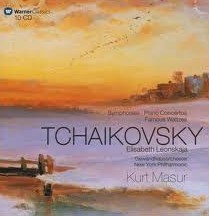 Eleven years later Tchaikovsky composed his fifth symphony. By then he was Russia’s most prominent composer at home and abroad. Again, the idea of fate ran through the whole work. He noted, “Introduction: complete surrender to fate or—and this is the same thing—to the 6)inscrutable decrees of providence.”
Eleven years later Tchaikovsky composed his fifth symphony. By then he was Russia’s most prominent composer at home and abroad. Again, the idea of fate ran through the whole work. He noted, “Introduction: complete surrender to fate or—and this is the same thing—to the 6)inscrutable decrees of providence.”
11年后,柴可夫斯基谱出了他的第五交响曲,当时他已经是俄罗斯远近驰名的作曲家,而关于命运的想法再一次贯穿了他的整篇曲谱。他记录道:“开篇:完全屈服于命运,或者——这是一样的——屈服于不可预知的天意。”
Tchaikovsky was highly sensitive. Outwardly, the impression he made was balanced and self-controlled, but in reality he was very insecure; an unstable, tormented personality. He was prey to 7)dire visions and nightmares and his diary is full of astonishing and distressing disclosures about the psychological 8)agonies he went through. He wrote to Nadezhda Von Meck expressing his fear that he was “written out”, but he completed the fifth symphony within the space of three months. Tchaikovsky conducted the first performance himself on the fifth of November, 1888, in St. Petersburg. His brother, Modeste, was present.
柴可夫斯基的性格极其敏感。表面看来,他给人的印象是平稳而自制的,但实际上他非常缺乏安全感,性格不稳定且苦闷。他经常遭受可怕的幻象和梦魇的折磨,而他的日记中则大量暴露了他所遭受的惊人的心理痛苦。他在写给娜婕达·冯·梅克的信中说,他担心自己已经“才思枯竭”,可是他依然在三个月内完成了第五交响曲。柴可夫斯基于1888年11月5日在圣彼得堡亲自指挥了交响曲的首演。他的弟弟马戴斯特到场观看了演出。
After the symphony Pyotr Ilyich received a rapturous applause. The orchestra played three 9)flourishes for him and he was presented with flowers. But despite its great success with the audience, many critics found fault with the new symphony. But by no means all of them. After the first German performance five months later, the Hamburg reviewer Josef Zitaud, wrote, “The E-minor symphony can rightly be hailed as one of the most significant symphonic works of the age.” Today, Tchaikovsky’s “Fifth” is among the most famous symphonies ever written.
演出结束后,彼得·伊里奇获得了热烈的掌声。乐队三度吹奏对他表示感谢,还有人向他献花。然而虽然演出大受观众欢迎,取得了极大的成功,许多批评家还是对这篇新交响曲吹毛求疵。但并不是所有批评家都不喜欢它。五个月后在德国首演之后,汉堡的评论家约瑟夫·齐达德写到:“准确说来,这篇E小调交响曲可以被拥为是本时代最重要的交响曲之一。”今天,柴可夫斯基的第五交响曲已经被看作是有史以来最著名的交响曲之一。
Pyotr Ilyich Tchaikovsky was born on the 7th of May, 1840, in a small mining town west of the 10)Urals called Votkinsk. His mother, Alexandra Andreyevna, played the piano and introduced her son to the world of music. The highly sensitive boy responded with passionate interest. Though his musical gifts were encouraged by his parents, the lowly social standing of professional musicians meant they never seriously 11)contemplated a musical career for him. At the age of ten he was sent to the School of 12)Jurisprudence in St. Petersburg, which he left nine years later to take up a junior post in the Ministry of Justice. He described himself as “a poor civil servant”.
彼得·伊里奇·柴可夫斯基于1840年5月7日出生于乌拉尔河西岸一个名叫沃特金斯克的矿业小镇上。他的母亲亚历山德拉·安德列叶夫娜会弹钢琴,并将儿子领进了音乐的世界,这个性格极其敏感的男孩对此显露出了极大的兴趣。虽然他的音乐天赋得到了父母亲的鼓励和支持,然而由于当时职业音乐家的社会地位低下,这也就意味着他们并没有真的打算将来让他以此为职业。在10岁的时候,他被送往圣彼得堡的法学院学习,9年后他离开了那里在司法行政部谋得了一份小差事。他形容自己是一个“可怜的小文员”。
Finally, in 1862, he enrolled at the new St. Petersburg 13)Conservatory of Music established by 14)Anton Rubenstein. Rubenstein persuaded him to devote himself entirely to music. In a letter to his sister, Tchaikovsky says, “This is my vocation and I must follow it. Whether I become a great composer or a poor music teacher is immaterial. 15)At all events my conscience will be clear and I shall no longer have any cause to complain about my 16)lot.”
最后,在1862年,他被圣彼得堡的音乐学院录取了,该学院是由安东·鲁宾斯坦刚建立起来的。鲁宾斯坦劝说他全身心地投入到音乐创作中去。在一封写给他妹妹的信中,柴可夫斯基说道:“这就是我的天职,我必须服从它。不管我是会成为一位伟大的作曲家,还是一名贫穷的音乐教师,这都不重要。无论如何,我的意识很清醒,而且我也不再有任何理由去抱怨我的命运。”
After successfully completing his studies in St. Petersburg, Tchaikovsky spent twelve years teaching music theory at the new conservatory in Moscow. His first four symphonies and many other works date from this period, so it was productive for him as a composer, but it was also a time of distress and unrest. Tchaikovsky was homosexual and that was a social 17)stigma. To avoid the inevitable 18)ostracism associated with it, he resolved to marry Antonina Miliukova, a woman he hardly knew. The marriage was a disaster. Tchaikovsky suffered a complete nervous breakdown and tried to kill himself. After separating from his wife in 1878, Tchaikovsky continued as an extremely successful 19)freelance composer. The vicissitudes he had been through strengthened his firm belief in the force of destiny.
在顺利完成了他在圣彼得堡的学业后,柴可夫斯基花了12年时间在莫斯科的一间新音乐学校教授乐理。他的前四部交响曲和许多其他乐章都是在这一时期完成的,所以作为一位作曲家,他算是很高产的,然而这段时期对于他来说也充满了忧伤与不安。柴可夫斯基是名同性恋者,而这在当时被看作是社会的耻辱。为了避免因此而受到社会的排斥,他决定娶安东妮雅·米露可娃,一个他几乎完全不了解的女子为妻。这场婚姻完全是场灾难,柴可夫斯基的精神完全崩溃了,还企图自杀。在1878年与妻子分居后,柴可夫斯基成为了一位极其成功的自由作曲家。他所经历的坎坷生活更坚定了他对命运之力的信仰。
The mysterious circumstances surrounding his early death at the age of 53 have 20)given rise to a great deal of speculation. We know that he drank a glass of unboiled water in a restaurant in St. Petersburg when 21)cholera was raging in the city. Some believe that he did this intentionally.
而他在53岁时神秘的英年早逝更是引起了各种猜测。我们知道的原因是在霍乱肆虐的时候,他在圣彼得堡的一家餐馆饮用了一杯未经煮沸的生水。有些人认为他是故意这么做的。
22)Igor Stravinsky, a great admirer of Tchaikovsky, said this about his countryman, “Tchaikovsky had a powerful sense of melody. It is the 23)centre of gravity in all his symphonies, operas and ballets. There is no doubt that he was an inspired creator of melody and that is a rare and precious gift.”
作为柴可夫斯基的热心崇拜者,伊戈尔·斯特拉文斯基对他这位同胞的评价是:“柴可夫斯基对旋律有着强大的感知力。这种感知力是他所有交响曲、歌剧和芭蕾舞曲的重心。毫无疑问,他是一位对旋律极有灵感的创作者,这是一种罕见而珍贵的天赋。”
对第二乐章的乐评
The beginning of the second movement takes us into an entirely different world. With quiet piano-24)pianissimo chords in the lower strings, it’s a very gentle introduction. Then comes a 25)cantilena on the horn; this is the main theme. The movement is marked “26)Andante 27)Cantabile 28)con alcuna licenza”, a songful andante with a degree of license. This is an allusion to the licenza of operatic arias, allowing the singer to modify the 29)tempo at his or her discretion.
第二乐章的开篇就将我们带入了一个完全不同的世界。随着轻柔的钢琴声和低音域和弦,这是一篇温柔的序曲。接着是圆号吹奏的抒情曲,这是主题旋律。这一乐章属于“稍自由的如歌的行板”,即旋律优美的行板但又带有少许的自由,像是在引用歌剧的唱腔,让歌手可以自行调节速度。
The horn cantilena is followed by an 30)oboe theme that Tchaikovsky refers to in his sketches as “a ray of light”. Both these themes 31)culminate in passionate climaxes, which, however, subside again almost as soon as they appear.
圆号之后紧接着是一段双簧主题,柴可夫斯基在草稿中将其称之为“光线”。这两个主题旋律都达到了高潮,不过几乎转瞬即逝。
If you think of the symphony in terms of a novel, I would say that this is an 32)idyllic episode. In fact, I think you could even call it a love scene. It opens as a dialogue between the horn melody and the oboe theme. In the central section you have constant give and take between different instruments or groups of instruments. Then there’s the indication “33)Con desiderio e passione”, which is very unusual.
如果你用小说来比喻交响乐,我想说这首犹如一篇田园诗。实际上,我认为你甚至可以将它称之为爱情诗篇。它以圆号曲调和双簧管主题的对话为开篇,在中段你可以经常听到其他单个或群体乐器此起彼伏。然后出现了激情片段,这是很少见的。
The central section introduces a new theme that builds to a 34)forte-fortissimo climax. At this point the full orchestra hammers out the “fate” theme. After a general pause, the 35)recapitulation sets in. Again, the two main themes are developed into a passionate climax. The “fate” theme intrudes once more before the coda brings the movement to a melancholy close built around the second theme.
中段出现了一篇新的主题,进入了新的高潮。此时整个乐团带出了“命运”这一主题。稍作停顿之后,进入反复部分。两个主题旋律再次营造出激情的高潮,接着在结尾处由第二旋律带出悲伤的曲调,再次出现命运的主题。
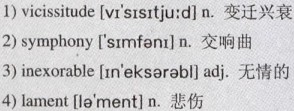

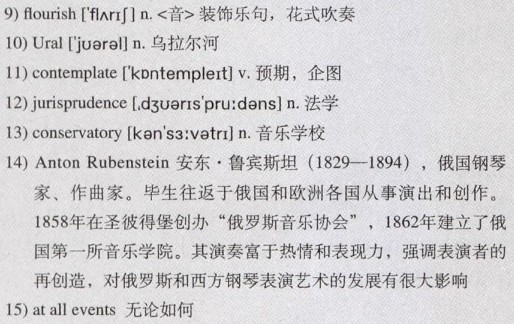
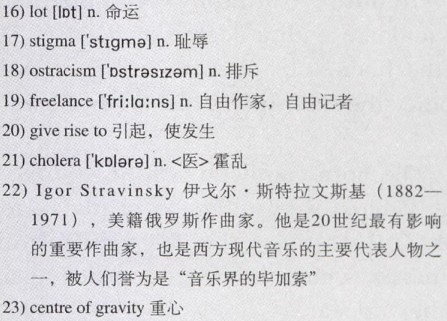
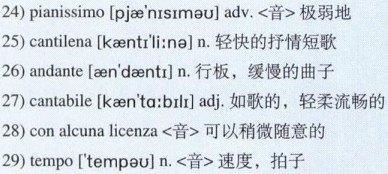
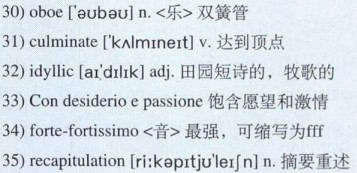
柴可夫斯基与冯·梅克夫人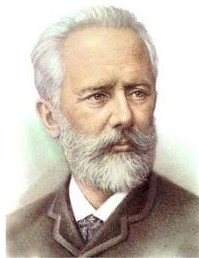 作为一位伟大的音乐家,柴可夫斯基的性格却是忧伤而内向的,只有一个人跟他有着亲密的关系,那就是娜婕达·冯·梅克夫人,但这也仅限于通信来往。冯·梅克夫人是一位富翁的遗孀,当她听过了他的《暴风雨》序曲的钢琴改编曲后,就被他的音乐所感动,从此开始资助他的生活,使他能够专心投入到音乐创作中去。然而在长达13年的时间里,他们恪守着彼此的承诺永不见面,只用书信连接着两个人的新,即使曾经只相隔一片草地的距离。
作为一位伟大的音乐家,柴可夫斯基的性格却是忧伤而内向的,只有一个人跟他有着亲密的关系,那就是娜婕达·冯·梅克夫人,但这也仅限于通信来往。冯·梅克夫人是一位富翁的遗孀,当她听过了他的《暴风雨》序曲的钢琴改编曲后,就被他的音乐所感动,从此开始资助他的生活,使他能够专心投入到音乐创作中去。然而在长达13年的时间里,他们恪守着彼此的承诺永不见面,只用书信连接着两个人的新,即使曾经只相隔一片草地的距离。
可是正当柴可夫斯基的事业如日中天的时候,却接到了冯·梅克夫人的一封信,说她已经处于破产的边缘再也无法供给他任何款项,而且他们之间的关系必须结束了。之后,满怀悲痛的柴可夫斯基写出了著名的《辈怆交响曲》。这是柴可夫斯基最后的作品,在这里面他留赠给世界的是他天才的光辉和悲痛的异彩。
《悲怆交响曲》MV卡拉扬版
